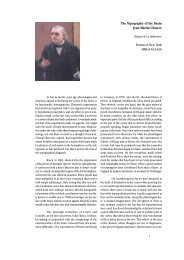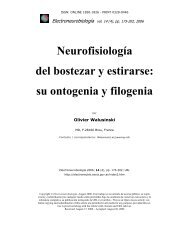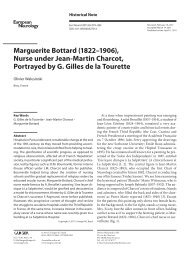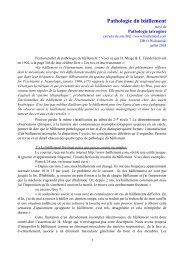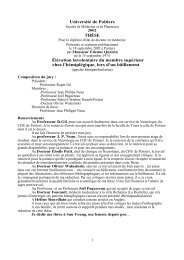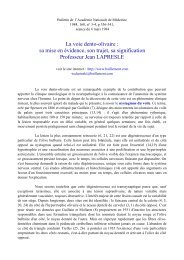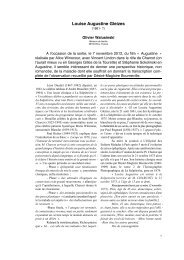YAWNING
YAWNING
YAWNING
Create successful ePaper yourself
Turn your PDF publications into a flip-book with our unique Google optimized e-Paper software.
J. Neurol. Neurosurg. Psychiat., 1958, 21, 203.Halfway between a reflex and an expressive movementyawning is a very commonplace phenomenon.Perhaps this is the reason why one searches invain for a paper on this subject in text-books ofcontemporary physiology or psychology and thatone must be content with the brief definition in thedictionary that " yawning is a deep inspirationmade voluntarily with a wide open mouth ".Many authors since Hippocrates, who seemshimself to have been interested in the question, havestudied either certain aspects or the whole problem.An excellent historical survey of the past knowledgeabout yawning may be found in the thesis ofTrautmann (1901), where are reported the opinionsof Galen, Oribase, Sanctorius, Fernel (1610),Kruger (1627), Sennert (1666), Boerhave (1680),Gartner (1736), Albertini (1737), Gunz (1738),Czerniewski (1749), Buchner (1758), Roederer(1759) Haller (1766), Walther (1775) Double (1817),Adelon (1821), Rothmund (1824), Richerand (1825),Muller (1851), Monneret (1861), Longet (1868),and Dechambre and Charcot.In the twentieth century more papers have beenwritten, among others by Hauptmann (1920),Dumpert (1921), Mayer (1921), Insabato (1928),Peiper (1932), Moore (1942), and Salmon (1948).Two good critical reviews are those by Heusner(1946) and Boudouresques (1950).The zoologists have not remained indifferent, andthey teach us that yawning may be observed in theprimates and the carnivores. It is often accompaniedby stretching. It is not observed in herbivores. It isdifficult to specify its significance, and the connexionbetween yawning and the movement of opening themouth that may be observed in fishes, reptiles, andamphibians. The same may be said of the movementsmade by the bird's beak accompanied byflapping of the wings. Therefore our study shallremain limited to man.Analysis of YawningYawning is an involuntary, paroxysmal breathingmovement. It is a motion unfolding itself in a certainorder, wherein three phases may invariably be<strong>YAWNING</strong>BYJACQUES BARBIZETFrom the Hospital of Saint Antoine, Parisdistinguished: the first one is active and inspiratory;the second phase corresponds to the acme; thethird is passive and expiratory. Their respectiveduration is about 1-5 to 4 sec. each. An averageyawn lasts from 4 to 7 sec.An analysis of the subject's movements may bemade by a clinical survey or by the study of radiographstaken every half second, as we have done atSt. Antoine Hospital with Dr. Chalut.In the first phase we see the progressive openingof the mouth, the dilatation of the pharyngo-larynxand of the thorax, and the lowering of the diaphragm.The opening of the mouth is very slow,and the mouth is still half open when the dilatationof the pharynx and the larynx is already at itsmaximum.The lowering of the neck's air axis is obviousfrom simple inspection, which shows the loweringof the thyroid cartilage. A radiograph shows thatthe body of hyoid bone, which stands at rest at thelevel of C.2-3 vertebrae goes down to C.6-7, andexplains the tongue's situation as it is pulled backwardand downward, the tip going well away fromthe teeth. The dilatation of the glottis and the203abduction of the vocal cords can be verified by alaryngoscopic examination sufficiently long continuedto catch a spontaneous yawn. The radiographshave shown that the dilatation of the pharynxis enormous and surprising, for it increases to threeor four times its normal size (Fig. 1 and 2). Thepharynx, larynx, and trachea, as well as the bronchialtubes, appear very dilated on the plates.While the opening of the mouth and the deepinspiration may be observed in many cases apartfrom yawning, the enormous expansion of thepharynx with the lowering of the hyoid bone andof the tongue is peculiar to yawning.It is to be noted that the inspiratory sound observedin yawning is produced in the palate and thethroat's isthmus. It is not a glottal noise, the glottisbeing dilated to its utmost at this phase.The second phase of yawning corresponds to theacme of the mouth's opening and to that of thepharyngeal and thoracic dilatation. Certain pre-
204JACQUES BARBIZET...,_5*:!_..;.*u_.*_ *5,!_*s-FIGS. 1 and 2.-Radiographs of the pharynx before and during yawning.disposed subjects may even at this point dislocatethe jaw. At this moment appear the facial modificationswhich began at the end of the first phase.Contraction of the lip dilators exaggerates themouth's opening and contraction of the eyelidscauses a partial or even a total occlusion of the eyes.The nostrils are dilated. The skin at the base ofthe nose wrinkles and the eyebrows are lifted. Atthis phase there may also be a degree of toniccontraction of the extensor muscles of the neck andof the trunk, and may extend to include hyperextensionof the limbs. The stretching, which is farfrom constant, has the result of increasing thethoracic capacity. Tears may be secreted, and lessfrequently saliva.The third phase is passive. The inspiration ceasesabruptly. Expiration is slow and noisy, followedby the sound " aah" originated by the larynx. Thepharynx goes back to its normal size, the mouthcloses itself, and the face resumes its usual aspect.This group of complex and synergic motionsconstitutes yawning. However, yawning may beaccompanied by other motions emphasizing orminimizing its action. Yawning may be exaggeratedand emphasized by stretching of the limbs, or by amodulation of breathing, or by the execution ofrhythmic lateral motions of the mandibles.Yawning can also be repressed to a certain extentin circumstances where it would constitute badbehaviour; the subject puts his hand before hismouth. He can also repress a yawn by stoppingthe mouth's opening and controlling the inspiratorymotion. But, in spite of efforts, yawning is oftenbetrayed by such a gesture, and a stifled yawn doesnot escape a careful observer. In this case yawningmay be reduced to the action of the pharynx, whichonce more shows the importance of this phase.Certain physiological observations have beenmade during yawning, but they offer small reward.There may be a slight acceleration of the heart inthe inspiratory phase with a fall in the index ofcapillary oscillations in the finger tips. This phenomenonis of no great importance, as it may alsobe observed during deep inspiration (Heusner, 1946).An E.E.G., if performed in the act of yawning,cannot be interpreted owing to interference bymovements and muscle action.It is noteworthy that a yawn is rarely isolated.It usually occurs in fits of two or three. The intensityof the yawn often increases, and each yawn isseparated by a few regular breaths. Sometimes, theyawns will be repeated, irregularly, during severalminutes.Yawning and StretchingThese two actions are often but not alwaysassociated. Stretching is connected with the secondphase of yawning. Infants and animals stretch andyawn often at the same moment. In adults, stretchingis usually observed in the period of awakening. Theassociation of these two motions is far from constant.Yawning, even excluding cases where stretchingis repressed by good manners, is often isolated.Likewise, stretching after a long period in the sameposition is not accompanied by a yawn. These factsallow us not to give quite the same physiological
interpretation to these motions, especially as weshall see in the case of their functional value.The Cause of the YawnThere are numerous causes, which may be classifiedin three categories, physiological, pathological,and experimental.Physiological.-Drowsiness must be mentionedfirst; men and animals yawn when they are sleepy.They yawn also when they emerge from sleep. Somepersons are subject to yawning and stretching whenthey awake.Boredom is a frequent cause. It can be the consequenceof different circumstances-a dull talk, atedious lecture, a wearisome book. Weariness isintimately connected with a lack of interest fundamentalto the genesis of yawning.Seeing others yawning is infectious. " Interdumtamen sola imaginatio ossitationis causa est. Cumenim qui videt alium oscitare, ipse quoque adoscitandum invitatur" quoted Sennert in 1666."One yawn brings seven," is a popular saying.It is easy to make oneself yawn. Four or five deepinhalations with a wide open mouth, imitatingspontaneous yawning, provoke yawning. Once thespontaneous yawn has begun, it will seldom remainisolated, and during the following quarter of anhour will be followed by new isolated yawns or bya fit of yawning.Hunger or, the contrary, the plenitude after aheavy meal, are generally admitted as inducingyawning. In the second case yawning is associatedwith drowsiness. Certain plethoric patients seekmedical advice for these post-prandial yawns.Yawning is frequent in certain circumstances,such as physical weariness or pregnancy.Pathological.-Yawning is commonly observedin lesions of the brain-stem. It can also be seen inintrinsic lesions (haemorrhage, softening, tumours),and in compressions (posterior fossa tumours). Itis noteworthy to recall that drowsiness is a symptomof peduncular softening (Lhermitte).If yawning is commonly observed in hemispherictumours, especially frontal and temporal tumours,and in hemispheric haemorrhage, it is probably dueto indirect compression of the brain-stem provokedby intracranial hypertension or a temporal herniation.In such cases a yawn serves as an indicationof a brain-stem lesion and bears a bad prognosis.In the course of diffuse lesions of the brain,yawning is not infrequent. It has been observed incases of alcoholic encephalopathy and of generalparalysis of the insane.Yawning is frequent in respiratory sequelae toencephalitis lethargica, together with sighs andYA WNING 205spasmodic hiccup. Sicard and Paraf (1921) andTurner and Critchley (1925) mention spasmodicyawning and gaping. Choreics also yawn. Yawningcan be observed in certain varieties of epilepsy.Wilson (1940) interprets yawning as an " aura " ofvisceral crisis.Penfield and Jasper (1954) mention two observationsof yawning as an element of autonomicdiencephalic seizures. They cite the case of a womanof 29 with a large astrocytoma occupying the wholeleft temporal lobe and the lower portion of thecorpus striatum, whose fits started abruptly withoccipital pain accompanied by yawns and hiccupswhile at the same moment the left arm and the leftside of the mouth became numb. The fit endedwith a need to urinate.Yawning has been described very often and withmany details as a manifestation of hysteria (Charcot,Dejerine).Salmon (1948) points out that fits of yawning maybe a sign in myasthenia gravis and quotes one of hispersonal cases and one of Albertoni's. He indicatesthe action of prostigmine in stopping yawning.Yawning is also noted in the course of anaemia,haemorrhage, and shock, and during pyrexia, aswell as in digestive disturbances, though no one hastried to explain its mechanism in this case.Yawning and Cerebral Stimulation.-A comparisonis possible between the natural causes of yawningand yawning created experimentally by intracerebralstimulation, but we do not know of any researchwork. On the other hand, yawning has been studiedand noted in certain protocols. Hess (1938), bystimulating the intralaminar substance of the thalamusand the posterior subthalamus, has inducedsleep in cats after fits of yawning. The experimentsof Passouant, Passouant-Fontaine, and Cadilhac(1956) on the stimulation of the rhinencephalon, andparticularly of Ammon's horn, also mention yawning.The induced crisis has three phases: duringstimulation, reaction of escape, and during the postdischargeperiod, uneasiness with a diminution ofwatchfulness. In the third phase the animal stands,licks itself, purrs. This manifestation of well-beinglasts a few minutes, and sometimes the animal liesdown, stretches, yawns and goes to sleep.Sleep may start three or four minutes after thedischarge. An E.E.G. of the hippocampus showsthat it is preceded by sharp waves with increasedvoltage.It is obvious in this case that yawning is only alate and indirect manifestation of stimulation. Wemust remember, however, that it is integrated in abehaviour of well-being and sleepiness opposed tothe reaction of escape simultaneous with stimulation.
206The fact that yawning may be observed during thestimulation of the rhinocephalon or hypothalamus,formations which are functionally and intimatelyjoined with the reticular activating system, must beemphasized.Linked Yawning and Stretching.-In normal subjectsyawning and stretching may be independentof one another, but in some pathological conditionsthey are tightly linked. Dumpert (1921) and Lewy(1921) refer to the clinical observation of hemiplegicpatients in whom yawning was attended by stretchingthe paralysed arm. Heusner (1946) also mentionsspontaneous stretching of the paralytic arm provokedby a yawn.JACQUES BARBIZETPhysiology of YawningWhile the clinical aspects and the determiningcauses of yawning are well known, its physiologicalmechanism is no better known than its significance.Besides the fanciful interpretations already mentioned,a certain number of theories have beenbrought forward that may be classified in two groupsaccording to whether the yawn is a secondary or aprimary disturbance.In the first group yawning is considered as amechanism of regulation, just as shivering is consideredas an automatic reaction opposed to thecooling of the organism. No agreement has beenreached, however, either on the nature or on themechanism of this regulation.Hauptmann (1920) suggested that yawning andstretching were opposed to muscular hypotoniawhich, like boredom, is the consequence of theinactivity of superior brain centres. Salmon (1948)maintains that yawning is an automatic reaction ofthe respiratory muscles caused by hypotonia of therespiratory bulbar nerves and by the hypotoniathat follows sleep. But Dumpert (1921) wentfarther in this hypothesis. He considers that yawningoccurs when the brain circulation is not sufficientto maintain wakefulness and vigilance. Yawningand stretching should increase venous circulationto the heart first by compressing the veins of thetrunk and the limbs as well as the splanchnic veins;secondly, by diminishing the intrathoracic pressure.The resulting venous hypertension increases thecardiac output (Bainbridge's reflex) and consequentlyimproves arterial irrigation. The brain circulationbenefits especially, and, further, the sensory stimulifrom the stretched muscles produces, according toDumpert, systemic vasoconstriction and vasodilatationof cerebral arteries. Stretching, and to alesser degree yawning, might thus produce an increaseof blood circulation sufficient for the maintenanceof wakefulness.Among the functional theories of yawning, thehypothesis quoted by Heusner (1946) of a secretionof thyroxin determined mechanically by the compressionof the thyroid gland during yawning shouldbe mentioned.Beside these resolutely finalist theories, someauthors neglect the physiological consequences ofyawning and consider it as an accident connectedwith cerebral strain (Mayer 1921), just as crying andlaughing are the expressions of pain or joy.For Peiper (1932), yawning is a transitory disorderof the respiratory centres, weariness producing adecrease of the excitability of the superior respiratorycentres liberating an underlying centre for yawning.These theories, without being completely opposed,are based on unverified or disproved physiologicalhypotheses, such as the increase of venous pressureduring yawning or the decrease of the cerebral bloodflow when wakefulness ceases. They still leaveunexplained certain aspects of the psychomotorreflex described as yawning.In the light of contemporary knowledge of psychophysiology,it is possible to attempt an explanationof the mechanism of yawning, while neverthelessunderlining the gaps open to further research.The Mechanism of YawningYawning is a complex, involuntary, and paroxysmalact. Under the influence of a certain number offacts, a brief (4 sec. to 7 sec.) motor activity takesplace, bringing into play a great number of thoracocervico-facialmuscles. This suggests a criticalactivity spreading from one place to another in agiven neuronal circuit. With the knowledge of themuscles participating in yawning, it is possible tostate that the motor nuclei involved are located inthe bulb and in the cervical cord. It is thereforepossible to state that yawning, or more exactly themotion of the yawn, is connected with a paroxysmaldischarge involving a certain number of motornuclei situated in the bulb and in the cervical cord.The extension of this discharge to the nuclei of thetrunk and the limb muscles induces stretching.It seems impossible to specify whether there existsa hierarchy in this neuronal structure which wouldallow us to locate a " centre of yawning ". But, onthe other hand, we may note that this structure hasa close relationship to both the reticular formationand the cerebral cortex. The brain-stem reticularformation appears, according to a large number ofstudies of Magoun (1950) and of Moruzzi andMagoun (1949), to be capable of modifying the centralexcitatory state, and thus of controlling thedegree of alertness. It determines the level of consciousnessin its arousal capacities, alertness declining
in sleep and in pathological states related to sleep(drowsiness, torpor), and disappearing only in deepcoma, and, on the contrary, increasing in varyingdegrees according to the intensity of stimulation and,probably, to the extent of the nervous mechanismset in motion.Participation of the cerebral cortex cannot becontested when yawning is the result of complexpsychic activities such as imitation or boredom.It is interesting to recall in this connexion theexperiences of French, Hernandez-Peon, and Livingston(1955) showing that efferent pathways issuingfrom the cerebral cortex appear to project down tothe reticular formation.If we maintain this hypothesis, which should beverified, particularly by recording the neuronalactivity of the nuclei set in motion by yawningwith intrabulbar electrodes, the standard E.E.G.being uninformative, we must answer the followingquestion: Which are the responsible factors in theparoxysmal discharge in this bulbo-medullary motorstructure ?Circulatory and Humoral Factors.-These mustfirst be discussed because they have generally beeninvoked though without any accurate experimentaldata.The frequency of the yawn in the course ofanaemia or circulatory insufficiencies invokes thepossibility of bulbar anoxia or modification of theC02/02 ratio. We lack precise facts on this subject,but we can observe that voluntary apnoea, evenif it lasts some time, does not cause yawning. Thereis no proof that a slight variation of bulbar circulationwill carry with it anoxia. On the contrary, weknow the part played by Hering's nerve and thecarotid sinus in the regulation of cerebral circulationas well as the constancy of this circulation underphysiological conditions. Furthermore, one doesnot observe yawning when the central cerebralcirculation is insufficient, as in the paroxysmal fitsof bradycardia in the course of the Stokes-Adamssyndrome.Some authors also mention the part taken byhumoral modifications. Yawning and post-prandialdrowsiness may be attributed to an alkalotic waveor a discharge into the blood of polypeptids or lipidsof digestive origin. It could also be produced byintermediary metabolites due to muscular strain.Cramer (1924), noting the frequency of yawningin patients with colitis, assumed that it was due toan auto-intoxication by bacteriological toxins producedin the bowel. In fact, the existence of anendogenous origin has not been proved any morethan that of an endogenous hypnotic substance.Pharmacology provides, on the contrary, drugsYA WNING207predisposing to the appearance of yawning and ofdrowsiness, as is the case with morphine andhypnotics. The action of these substances on thereticular formation is well known, whereas caffeineand amphetamine have an opposite effect. In conclusion,if yawning can be induced by pharmacologicalmeans, there is no formal proof of thepart taken by circulatory or humoral disturbancesin the genesis of yawning.It must be noted that if such disturbances exist,which remains possible and must be the subject offurther studies, they could only be an adjuvantcause, their duration clearly exceeding the durationof yawning, which may or may not appear ininstances such as after meals, according to the psychologicalcondition of the subject.Psycho-sensorial Factors.-Spontaneous yawningmust be distinguished from yawning by imitation.Both are influenced by the surrounding circumstances,but in different ways.Spontaneous yawning occurs in particular physiologicalcircumstances such as weariness or sleepiness.In these cases, the subject lacks interest in hissurroundings and spontaneous thought diminishes.On the contrary, one does not yawn and even if oneis drowsy, one awakes if a new stimulus abruptlyappears. It may be physical stimulation or affectiveshock which rouses attention. People do not yawnat the very moment they learn the result of an importantexamination or the news of an accident to arelative. Yawning only occurs in psychologicalconditions of indifference or lack of interest insurroundings.Knowing the part played by the reticular formationin the mechanism of wakefulness, we proposethe following hypothesis. Yawning is an integrateddischarge in a bulbo-reticular motor structureoccurring at a particular level of activity of thereticular formation corresponding to a decrease ofwakefulness preceding sleep. This hypothesis, whichis in agreement with neurophysiological andpharmacological principles, explains why yawningmay be observed when a subject begins to sleep aswell as when he awakens. In our opinion, yawningappears as a physical manifestation of a drop inwakefulness. This paroxysmal motor discharge maybe compared with the muscular hypotonia observedduring sleep. It is the expression of a mode of beingand does not constitute a reaction against it. Itshould not play any physiological part. In fact,yawning, as we know, induces yawning and doesnot induce wakefulness. Yawning should be distinguishedfrom stretching, which perhaps has thefunction of setting wakefulness in motion.Yawning by imitation may occur in certain
208circumstances of release of interest, but the fact thatit can be induced shows that we maintain a certaindegree of consciousness in our surroundings whichinvolves some participation of our system ofwakefulness. The infectiousness of yawning is onlyone example of the numerous acts caused byimitation, often quite unconsciously, for instance,repeating a tune, raising or lowering one's voiceaccording to one's interlocutor, answering a grinby another grin, or a smile by a smile. In the sameway, some expressive acts such as laughing or cryingare infectious in certain circumstances. There is stillmuch to discover in the mechanism of association.However, the possibility of associating two stimulations,two ways of behaving, two ideas, is at thebasis of learning. Infectious yawning is just oneparticular case in a series of imitative gestures.It is also difficult to interpret the mechanism whichdetermines a real, spontaneous, irrepressible yawnafter a fit of false yawning. The passage of avoluntary act to a paroxysmal and involuntary oneis difficult to interpret on purely associative grounds,and one may wonder to what extent the fact ofyawning voluntarily, by a mechanism which remainsto be described accurately, has not modified neuronalexcitability, thus facilitating the paroxysmal andinvoluntary discharge.JACQUES BARBIZETPsycho-social Significance of Yawning.-Let useliminate from this discussion infectious yawning,an imitative gesture which is proof of a normallysuggestible subject and of his psychological irresponsibility,and let us return to spontaneousyawning.Without any physiological usefulness, spontaneousyawning has still a psychological significance: itshows lack of interest. This psycho-physiologicalconception carries with it certain considerations onthe social circumstances under which yawningoccurs.Yawning has an expressive mimic value as longas it indicates indifference and boredom. Theinterest or lack of interest that we feel for our surroundingscertainly depends on the nature of thesurroundings. The interest of the subject will bevery differently stirred according to whether he islying peacefully in silence and in darkness, orwhether experiencing sensory or psychic stimulation.This applies to infants as well as to adults. For thelatter, however, the interest he feels for the exteriorworld depends largely on his personality and hisformer experience. Interest is conditioned bydifferent factors, such as family, school, profession,social position. For instance, a conversation on anunfamiliar topic, or concerning an unknown person,causes lack of interest. The same could be said of adiscussion in a foreign language. It is well knownthat a connoisseur will bore the layman if he speaksat length on an esoteric subject. To a certain extentit is easy to know when the subject will please orbore, one's taste representing exactly what one isinterested in. The intimate connexion betweeninterest and personality explains the expressive valueof yawning, which appears as the mark of unconcernand disinterest. It may be said that yawning is toboredom what the gestures of laughing and cryingare to joy and sorrow.This interpretation of the significant value ofyawning agrees with the popular opinion thatyawning is a symptom of boredom. The fact thatit is polite to put one's hand before one's mouthwhen yawning, that is, to hide a yawn, a habitlearned in childhood and which becomes automaticto the point of being an integral part of the yawn,is an implicit acknowledgement of the social significanceof that motion expressing weariness andrefusal, which it is better to dissimulate.It is possible that in putting forward a digestivetrouble as an explanation of yawning the subjectunconsciously tries to hide the real cause, boredom.As an involuntary expressive gesture, yawning, is,however, a conscious phenomenon to which, in thecourse of its automatic development, voluntarymodulations may be added. For instance, a suppressedyawn shows an endeavour to dissimulateboredom. On the other hand, an emphasized yawn,long and noisy, proves in an unequivocal mannerthat the subject wants to show his weariness or evenhis aggressive attitude to a situation for which hedoes not feel any interest.SummaryThe different phases of the yawn are described,while the physiological and pathological causes areconsidered.The classical theories of yawning are discussed.The following views are put forward:(a) The yawn is connected with an integrateddischarge in a bulbo-cervical motor complex whichappears at a certain level of excitability of the consciousnessarousal system (reticular brain-stemformation) corresponding to the lessening of alertnesspreceding sleep.(b) This particular state of alertness depends onsensory stimulations received from the surroundings.It can also be induced experimentally by intracerebralelectric stimulation or by certain drugs (hypnotics).The part played by endogenous factors (circulatoryor humoral), though often discussed, hasnever been proved.(c) On physiological grounds, yawning appears
as the physical manifestation of a lowering of wakefulness,and does not seem to have any physiologicalfunction.(d) From the psychological point of view, yawningby imitation may be considered as one particularcase in the series of imitative gestures. Spontaneousyawning, on the contrary, may be included amongthe expressive gestures. Interest as well as lack ofinterest is intimately connected with the personality.Yawning, which expresses boredom, unconcern, andindifference to certain circumstances, has the valueof a refusal, and even in certain cases of an unconsciouslyor consciously aggressive attitude.REFERENCESBoudouresques, J. (1950). Baillement, p. 3.Chirurgicale-Neurologie-. T.1-17012 E.Encyclopedie Neuro-YA WNING209Cramer, F. (1924). Arch. Verdau.-Kra., 33, 149.Dumpert, V. (1921). J. Psychol. Neurol. (Lpz.), 27, 82.French, J. D., Hernandez-Peon, R., and Livingston, R. B. (1955).J. Neurophysiol., 18, 74.Hauptmann, A. (1920). Neurol. Zbl., 39, 781.Hess, W. R. (1938). Das Zwischenhirn und die Regulation vonKreislauf und Atnung, Vol. 1, p. 124. Thieme, Leipzig.Heusner, A. P. (1946). Physiol. Rev., 26, 156.Insabato, L. (1928). Arch. gen. Neurol. Psichiat., 9, 125.Lewy, E. (1921). Z. ges. Neurol. Psychiat., 72, 161.Magoun, H. W. (1950). Physiol. Rev., 30, 495.Mayer, C. (1921). Z. Biol., 73, 101.Moore, J. E. (1942). J. gen. Psychol., 27, 189.Moruzzi, G., and Magoun, H. W. (1949). Electroenceph. clin. Neurophysiol.,1, 455.Passouant, P., Passouant-Fontaine, T., and Cadilhac, J. (1956).Rev. neurol. (Paris), 94, 292.Peiper, A. (1932). Dtsch. med. Wschr., 58, 693.Penfield, W., and Jasper, H. (1954). Epilepsy and the FunctionalAnatomy of the Human Brain. p. 417. Churchill, London.Salmon, A. (1948). Presse med., 56, 739.Sicard, J. A., and Paraf, A. (1921). Bull. So^. med. H6p., Paris,45, 232.Trautmann, R. F. A. (1901). Le baillement. The.e de Medecine,Bordeaux (bibliography before 1900).Turner, W. A., and Critchley, M. (1925). Brain, 48, 72.Wilson. S. A. K. (1940). Textbook of Neurology, Vol. 1, p. 121 andVol. 11. pp. 1223 and 1507. Butterworth. London.





